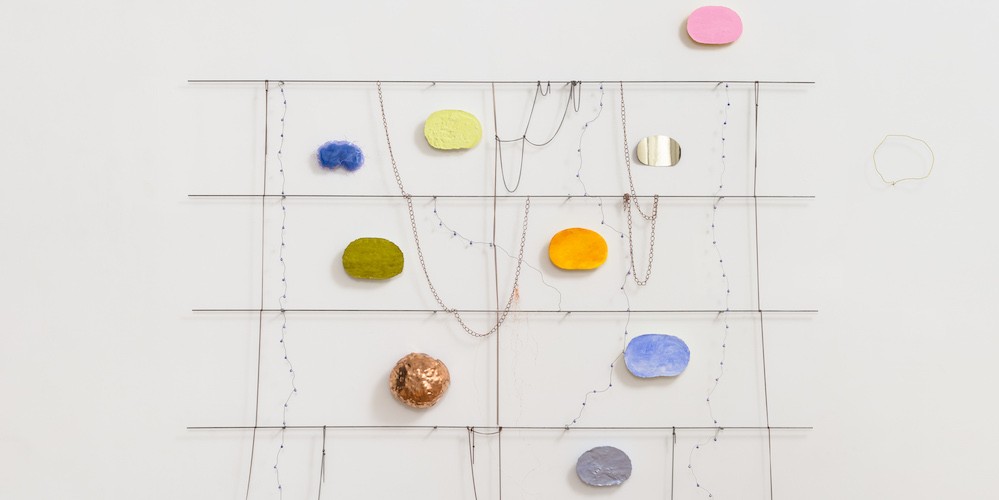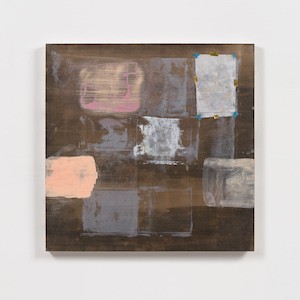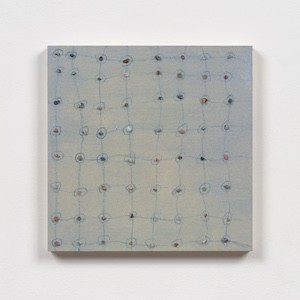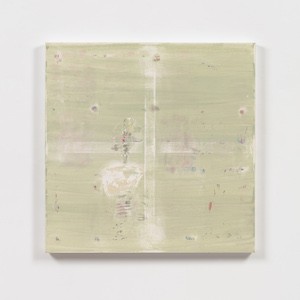Abby Robinson Encounters Light, Color, and Materials
Encounters is a series where we talk to Columbia Visual, Sound, and Performance artists about the art that compels them to see and create in new ways. This week, we caught up with Visual Arts alumna Abby Robinson ’22.
We begin with materials.
From the moment she began making art in early childhood, Abby Robinson has paid particular attention to sensation and materials. Her artistic practice combines observation and experimentation in equal measure: minute details are keenly observed and their sensorial impressions are not so much transferred onto canvas, wood, or plaster, as they are used to catalyze fresh experimentation. The result of this approach is an oeuvre that engages a viewer holistically, one might say, whole heartedly.
Robinson’s works ask and do not tell—they ask a viewer to consider the clandestine remnants of feeling, memory, and place alongside firmer facets of experience: patterns, accumulation, the boundaries a grid (or a square) makes. Her canvases are steeped in process, curiosity, and movement. For instance, Rock Grid (12" x 12," flashe paint, crayon, and rocks on wood panel, 2021) evokes a dance upon the surface of a wooden block like light shimmers on the surface of water. See Better (36" x 36," acrylic, oil, silkscreen, vellum, image transfer, gouache, tape, on wood panel, 2023) uses a subtle yet highly effective grid overlay to suggest speed and the sensation of gliding across a surface. Remnants (36" x 36," acrylic and paper on canvas, 2023) draws close attention to materiality and experimentation: the cross down the middle is sanded into the canvas instead of painted over its primed fibers. Robinson’s work lives in conversation with a host of abstract, materially driven artists like Jack Whitten, Lucio Fontana, and Rachel Harrison, while simultaneously expressing a perspective and style that is deeply her own.
We began our conversation over email and continued in her light-filled studio on Canal street. Ahead of our meeting, Robinson sent along the following note regarding some of the first artwork she remembers encountering:
“Growing up, the works of Frank Stella, Ida Kohnmeyer, George Dureau, and Margaret Witherspoon were some of the first artists’ works I experienced in person. I can remember seeing a Monet show at the New Orleans Museum of Art in my grade school years and that was very impactful. I’ve always been drawn to abstraction and the grid from a young age, and can remember learning about Mondrian and Agnes Martin for the first time and feeling such freedom, possibility, and license to not make representational work.”
The grid is a spatial and aesthetic component in abstract and minimalist art and exists in a variety of iterations. John Elderfield, the former Chief Curator of Painting and Sculpture at the Museum of Modern Art, New York, advanced two ways of considering a grid on a canvas: the additive or the subtractive. Whereas the additive grid relies on accumulation to establish dynamism and inter-relationality among the elements on a surface, the subtractive grid is more rigid, lines are divided into a vertical and horizontal axis upon which every element is organized. In Robinson’s works, one may glimpse the use of both grid styles. Much of this has to do with her artistic disposition, which posits that “joy, beauty and vibrancy are as possible as grit, absence and profundity.”
Let’s start with your love of materials. Tell me about when that started for you or when it became deeply apparent in your work.
Abby Robinson: It’s always been going on. I grew up in New Orleans, which has a very rich visual culture. There was a grittiness and a luster to that environment: the magic of Carnival, the beads, the worn quality of everything, the pastels with the vibrant colors, the brick and plaster and Spanish and French influences. So architecture, the iron work, glass and wood, and all of those materials were always a part of my visual experience.
In my practice, I’ve always been really drawn to working with a lot of different materials (like clay, paper, paint, canvas, wood, making things out of found objects like sticks or rocks or twine). I explore a lot of different solvents and surfaces, and that also relates to light and color and how everything interacts differently.
From what you’ve told me, you draw a lot from the natural world as well as from the in-studio experimentation environment. How do these two facets interact in your work?
AR: I walk to the West Side highway a lot and I notice how the same stretch of water looks different depending on how the light hits it and how a shadow can create iterations in how it feels. In the studio, I really like to take a material—whether it’s the surface or the pigment or both—and get to know it and push up against it. I’ll make a circle with a string. Next, I'll be painting over it and removing the string, and then have a trace of it. Then I'll take an image of that and make a silkscreen out of it. Or I’ll carve the same image into copper. Working becomes a way of recognizing ideas that I want to keep moving through different materials—a color, a shape, a texture, a quality of line.
So, why abstraction?
AR: It’s never been a question for me: abstraction or not. I’ve always been drawn to patterns, colors, shapes—and abstraction has allowed me more possibility, freedom, mystery, and openness.
I’m thinking now of Ida Kohlmeyer, who was born in New Orleans. She focused on abstract symbols within a gridded pattern. It seems there’s a connection between her approach and your own, especially in terms of working within abstraction but within your own schematic codes and found patterns.
AR: Yes, Ida Kohlmeyer’s a Louisiana artist who I became exposed to when I was little. I was drawn to her symbols, shapes, colors, patterns, textures, working across scale, and also making sculptures, working on paper a lot.
In reading about and seeing her works, I was drawn to that tension within her paintings between the use of symbols and the questioning of symbols and their arbitrariness. In many ways she refuses the idea that a symbol can ever be static.
AR: Yes, her use of X's or differently shaped symbols that she could recreate or transmute in a different way. In my practice, different materials I choose to use become a part of my visual language and have symbolic connotations, whether it’s silk, which is more domestic, or copper, which suggests alchemy, or rocks, which I use for color and scale, but also have mystical connotations.
That seems like a very cool way to build out a world throughout your work.
AR: Yes, that’s how it’s developed, through accumulation and iteration of working ideas through materials. I didn’t seek it out but that’s how the work has evolved. There’s so much to explore with what’s in here in the studio.
Before the pandemic, I was so inspired by my travels, being in an immersive natural setting, and seeing changes of light—I felt really attached to that. But then during most of the pandemic I was in the city, in an urban setting, in class all day, not spending a lot of time outside. For a while I thought I was going to lose my source of inspiration and I think the opposite has been true. While I am still very inspired by nature, in some sense, I think that I subconsciously created aspects of the calm I experience in those awesome natural settings in the work itself.
Which is funny, because that is one of the first things I said when I walked in: it feels so peaceful and tranquil in here, which stands in stark contrast to all that’s going on outside, on Canal street. It seems that the materiality of found objects, or things that are not usually included in classical art, have continued to play an important role in your work. From my perspective, the way you utilize materials allows abstract art to stake a claim on reality as much as representational art does. What is really neat is that you’re doing this by foregrounding the materials used in art-making as well as pushing that conversation forward beyond materiality. Whereas in traditional representational work the materials are quite hidden—the brushstrokes, for instance, are really small, and you’re hiding so much to create the image— here, in your abstract artworks, everything is moved to the forefront without being simplified or stripped of wonder.
AR: Definitely. I draw a lot from my experience of reality. Just walking down the street and seeing the reflection of a pattern on the metal gate covering of a storefront, or from construction sites, where the plywood’s painted over but chipping and there’s a portal made of chicken wire where you can see through–there's a whole scale thing going on and multiple layers of materials….that kind of thing I go crazy for.
Is time a component in your work? There are so many stains and layered marks in your work, so, for me, there is a conversation with time happening.
AR: Yes, there’s definitely time. In a lot of work, there’s a fast part and a slow part. I like being able to freeze moments on the surface. The moment when I applied the paint, the amount of water, the amount of viscosity, etc.
Let’s talk more about the grid. One of the artists you mentioned when asked about your early art encounters was Mondrian, who employs the grid, and you also mentioned Agnes Martin. So tell me about the grid and lines and how you started having that visual relationship with space.
AR: I always loved architecture. The front of a building is, in some ways, like a painting: there are shapes and objects placed on this frontal plane. I think a grid becomes a framework through which to play with materials and gives some structure to a space, whether it’s gridded paper or a window.
I’m thinking, too, of the grid being able to contain a series of moments that occurred during those mark-makings. It contains it in a way that gives it structure but without stifling it. Can you speak to why you prefer square canvases? Is it related to your use of the grid?
AR: I’ve tried a lot of other canvas sizes, but the square has remained my preference. The square just feels right, even and whole—it’s closest to whatever it is I’m experiencing if I just open my eyes. And of course, grids are all comprised of squares.
It’s kind of like a 35mm lens on a camera, which is closest to the eye’s natural parameters. I’d never made this connection myself—between the circle and the square and the body—but being among your works, it seems there is a thru line and a connection among these, because I’m feeling the effect of standing before each square canvas and it feels remarkably inviting rather than being before a rectangle, or a painting that’s organized horizontally or vertically on a rectangle shaped canvas. Suddenly the rectangle suggests a different relationship between my physical body and the painting itself. Now, the square feels both cavernous and inviting at the same time.
AR: Yeah totally, I don’t work knowing the final orientation of the painting. I work from all four sides, on a table, usually, or on the floor. And I like investigating the edge. The edge doesn’t feel like a restriction, it just feels like a place to contain the experiment. I can always continue it on another surface.
What’s next in your practice?
AR: Right now I’m working on finishing a group of larger paintings and sculptures that I began earlier this year and getting back into the metal shop. I’ve also been exploring larger scale silkscreens. Aside from working in the studio, I have a trip planned to Europe this summer. I’m excited for a change of scene, travel always invigorates my practice.
Abby Robinson (b. 1984, New Orleans, Louisiana) is a visual artist who lives and works in New York City. Robinson received her Masters of Fine Arts from Columbia University School of the Arts in 2022. Her work has been featured in New American Paintings (2022), Architectural Digest, and exhibited in several group exhibitions including at The Fireplace Project in East Hampton, NY, half gallery in New York, NY, bungalow at Westbeth Gallery in New York, NY, and Golsa Gallery in Oslo, Norway. Robinson lives and works in New York, NY. She recently displayed works at the Independent Art Fair with Tilton Gallery from May 11 to May 14, 2023.



